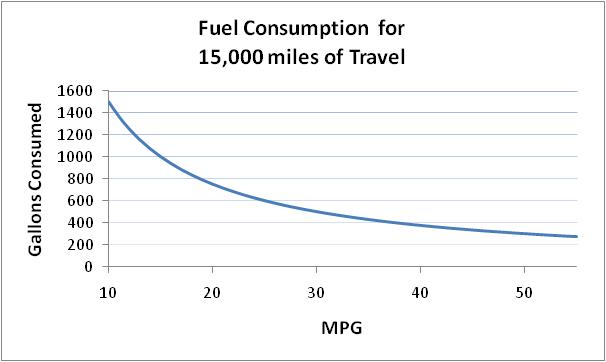Quick question: Which saves more fuel, a 2 mpg increase or a 16 mpg increase? While most people would logically choose the latter, the correct answer is, in fact, “it depends.” It depends on where along the fuel economy spectrum each increase is occurring. Believe it or not, for a fixed distance of travel, a 2 mpg increase from 14 to 16 mpg will save just as much fuel as a 16 mpg increase from 35 to 51 mpg. This has some important implications for both vehicle shoppers and policymakers, but before we get into that, let’s look at why the numbers shake out the way they do.
The reason is that the metric of fuel economy – miles traveled per gallon consumed – does not have a linear relationship with the amount of fuel consumed. Let’s look at the issue visually. The chart below plots gallons consumed over 15,000 miles of travel against a range of fuel economies. As you can plainly see, the curve is steeper in the lower-mpg range; a one-mpg improvement will offer you more fuel savings the lower you are on the spectrum.
Now let’s highlight the fuel economies in question. An increase from 14 to 16 mpg (the two red dots on the chart below) will lower consumption from approximately 1071 gallons to 937, a savings of about 134 gallons. Further up the curve, an increase from 35 to 51 mpg (the two green dots) will lower consumption from about 428 to 294 gallons, a difference of 134 gallons – roughly the same amount.
What’s the takeaway from all of this? Well, a few things. First, it’s important for people who are in the market for, say, a large SUV to realize that a seemingly-paltry few mpg can actually add up to serious oil savings. Trucks usually come in multiple options, and thus offer great opportunity to get these savings. Check out the 2wd rather than 4wd version. Or the V6 instead of the V8. As you can see, a couple mpg can mean serious savings at the pump
These charts are also hard proof that if we want to cut our nation’s oil addiction, we need find ways to increase the fuel economy of our lowest-mpg segments – generally mid-to-large SUVs and pickups. Putting fuel saving technology in our cars alone is simply not enough.
As to the vehicles on the upper end of the spectrum, it’s true, an on-road fuel economy of 55 mpg wouldn’t save you that much more fuel over an on-road fuel economy of 50. Which is all the more reason that advanced designs using electric drivetrains (such as plug-in hybrids or electric vehicles) will be critical to cutting our oil consumption and global warming pollution in the coming years. We’re just now starting to see these technologies coming to market (Chevy Volt, Nissan Leaf, Toyota Prius Plug-in, for example) and their volumes are still low. But in time, I have high hopes for the role these technologies can and should play.
That’s my perspective, but what do you all think?


